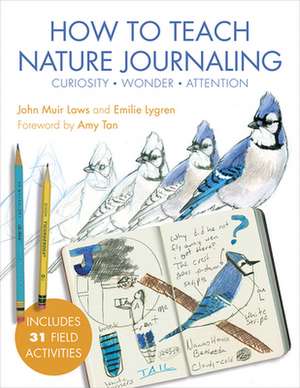How to Teach Nature Journaling
Autor Emilie Lygrenen Limba Engleză Paperback – 13 mai 2020
The first-ever comprehensive book devoted to helping educators use nature journaling as an inspiring teaching tool to engage young people with wild places.
In their workshops, John Muir Laws and Emilie Lygren are often asked the how-tos of teaching nature journaling: how to manage student groups in the outdoors, teach drawing skills (especially from those who profess to have none), connect journaling to educational standards, and incorporate journaling into longer lessons. This book, expanding on the philosophy and methods of The Laws Guide to Nature Drawing and Journaling puts together curriculum plans, advice, and in-the-field experience so that educators of all stripes can leap into journaling with their students. The approaches are designed to work in a range of ecosystems and settings, and are suitable for classroom teachers, outdoor educators, camp counselors, and homeschooling parents.
Full-color illustrations and sample journal pages from notable naturalists show how to put each lesson into practice. Field-tested by over a hundred educators, this book includes dozens of activities that easily support the Common Core and the Next Generation Science Standards—and, just as important, it will show kids and mentors alike how to recognize the wonder and intrigue in their midst.
Preț: 186.39 lei
Nou
35.68€ • 38.77$ • 29.99£
Carte disponibilă
Livrare economică 31 martie-14 aprilie
Livrare express 15-21 martie pentru 51.85 lei
Specificații
ISBN-10: 1597144908
Pagini: 288
Dimensiuni: 216 x 279 x 17 mm
Greutate: 0.95 kg
Editura: HEYDAY
Notă biografică
Cuprins
Foreword by Amy Tan
INTRODUCTION
NATURE JOURNALING ACTIVITIES
INQUIRY, INVESTIGATION, AND SCIENTIFIC THINKING
WORDS: ARTICULATED THOUGHT AND STORYTELLING
PICTURES: DRAWING AND VISUAL THINKING
NUMBERS: QUANTIFICATION AND MATHEMATICAL THINKING
INCORPORATING JOURNALING INTO LESSONS, FRAMEWORKS, AND ASSESSMENTS
FINAL THOUGHTS
APPENDICES
Notes
Acknowledgements
About the Naturalist Journal Contributors
About the Authors
